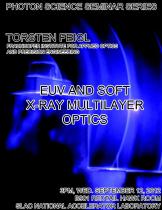Torsten Feigl, Fraunhofer Institute for Applied Optics and Precision Engineering IOF
Extremely powerful EUV and X-ray sources have been developed over the past decades, or are being developed at this time. Among them are electron storage rings emitting synchrotron radiation, laser or discharge produced plasmas and X-ray free electron lasers. Not surprisingly, there is an increasing interest in optical components for the extreme ultraviolet (EUV), soft and hard X-rays.
Due to absorption at wavelengths between 1 nm and 100 nm the penetration depth of EUV radiation into matter is only a few nanometers. Hence, reflective optics must be used for imaging and light collection such as EUV multilayer mirrors which consist of alternating thin films with different refractive indices. This basic idea can be compared to the classic, high reflective l/4 systems: the constructive interference of all beams reflected at the film interfaces.
At Fraunhofer IOF Jena multilayer optics development cover the full range between the soft X-rays around 2 nm wavelength and the vacuum ultraviolet. However, the paper will focus on multilayer optics for EUV lithography applications at 13.5 nm. Besides the development of high-reflective multilayers with enhanced thermal and radiation stability using interface engineering and optimized capping layers collector and imaging optics for diverse applications in the EUV spectral range have been realized. The deposition of EUV collector mirrors for high-power laser produced plasma (LPP) sources as well as the realization and testing of diffraction limited EUV Schwarzschild objectives are discussed.
The paper summarizes recent progress and the present knowledge in preparation and characterization of multilayer optics for the EUV and soft X-ray range with regard to different designs, minimization of structure imperfections, thermal and radiation stability.





